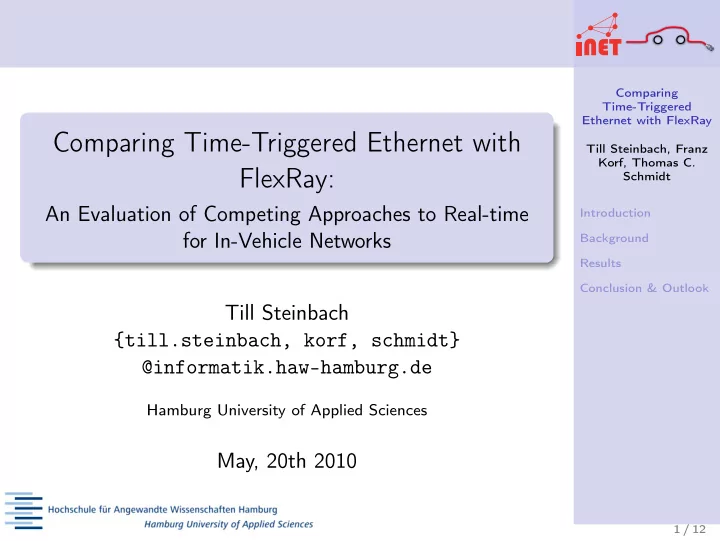

Comparing Time-Triggered Ethernet with FlexRay Comparing Time-Triggered Ethernet with Till Steinbach, Franz Korf, Thomas C. FlexRay: Schmidt An Evaluation of Competing Approaches to Real-time Introduction for In-Vehicle Networks Background Results Conclusion & Outlook Till Steinbach {till.steinbach, korf, schmidt} @informatik.haw-hamburg.de Hamburg University of Applied Sciences May, 20th 2010 1 / 12
Introduction Motivation and Problem Statement Comparing Time-Triggered Ethernet with FlexRay Till Steinbach, Franz FlexRay is considered the next generation technology Korf, Thomas C. Schmidt for in-car networks Introduction Background Results Conclusion & Outlook 2 / 12
Introduction Motivation and Problem Statement Comparing Time-Triggered Ethernet with FlexRay Till Steinbach, Franz FlexRay is considered the next generation technology Korf, Thomas C. Schmidt for in-car networks Bandwidth requirements increase rapidly Introduction Background Current in-vehicle networks are inhomogeneous Results Conclusion & Outlook 2 / 12
Introduction Motivation and Problem Statement Comparing Time-Triggered Ethernet with FlexRay Till Steinbach, Franz FlexRay is considered the next generation technology Korf, Thomas C. Schmidt for in-car networks Bandwidth requirements increase rapidly Introduction Background Current in-vehicle networks are inhomogeneous Results Time-triggered Ethernet promises real-time and Conclusion & Outlook best-effort traffic in one backbone network 2 / 12
Introduction Motivation and Problem Statement Comparing Time-Triggered Ethernet with FlexRay Till Steinbach, Franz FlexRay is considered the next generation technology Korf, Thomas C. Schmidt for in-car networks Bandwidth requirements increase rapidly Introduction Background Current in-vehicle networks are inhomogeneous Results Time-triggered Ethernet promises real-time and Conclusion & Outlook best-effort traffic in one backbone network Usage of components of the shelf Benefit from the expertise of the plenty Ethernet developers 2 / 12
Introduction Objectives Comparing Time-Triggered Ethernet with FlexRay Till Steinbach, Franz Korf, Thomas C. Schmidt Competitive analysis of FlexRay and TTEthernet Introduction Show eligibility of TTEthernet for in-vehicle Background applications Results Conclusion & Outlook Provide framework for performance appraisals of Ethernet based in-vehicle communication 3 / 12
Background FlexRay Internals Comparing Time-Triggered Ethernet with FlexRay Till Steinbach, Franz Bandwidth Korf, Thomas C. ECU ECU ECU 10MBit/s per channel Schmidt Introduction Background Results bus cycle i bus cycle i+1 Conclusion & Outlook dynamic symbol network static segment static segment segment window idle time Time-Triggered Messages Event-Triggered Messages 4 / 12
Background TTEthernet Comparing Time-Triggered Ethernet with FlexRay Till Steinbach, Franz Linkspeed Korf, Thomas C. 100MBit/s or 1GBit/s Infotainment Schmidt BE BE BE Introduction TTE-Switch ECU 0 t Background LIN-BUS LIN-Gateway TT RC BE BE TT BE Results t RC cycle Conclusion & Outlook 0 0 t chassis TT Time-Triggered Message TT TT RC Rate-Constrained Message t cycle Best-Effort Message 0 BE 5 / 12
Comparison Framework and Parameters Comparing Time-Triggered Ethernet with FlexRay Till Steinbach, Franz Korf, Thomas C. Analytical framework that can be adapted to varying Schmidt topologies Introduction Concrete results based on a sample configuration Background Topology with two stars / switches Results 16 ms cycle Conclusion & Outlook Latency and Jitter are calculated for the sample configuration Bandwidth is compared over various payload sizes 6 / 12
Results Latency and Jitter Comparing Time-Triggered Ethernet with FlexRay The analytical results for jitter and latency of Till Steinbach, Franz FlexRay and TTEthernet are comparable Korf, Thomas C. Schmidt Switching delays in TTEthernet cause higher latency Introduction in large topologies Background Jitter is nearly unaffected by the number of switches Results in the network Conclusion & Outlook FlexRay TTEthernet latency min. payload 12.2 µ s 24 µ s latency max. payload 265.2 µ s 372 µ s jitter bounds 6.4 µ s < 10 µ s 7 / 12
Results Real-time slots at payload size Comparing Time-Triggered Ethernet with FlexRay &"!! Till Steinbach, Franz '--.*/+01+* Korf, Thomas C. &!!! '2$+34"# Schmidt !"#$%#&%'()'#%*$+'(,%-*.(/01 Introduction %!! Background $!! Results Conclusion & Outlook #!! "!! ! ! "!! #!! $!! %!! &!!! &"!! &#!! !"#$%"&'()#*+, 8 / 12
Results Net bandwidth at payload size Comparing 100 Time-Triggered TTEthernet Ethernet with FlexRay 90 FlexRay Till Steinbach, Franz 80 Korf, Thomas C. Schmidt 70 10 Bandwidth [Mbit/s] 9 60 Introduction 8 50 7 Background 6 40 5 Results 4 30 Conclusion & Outlook 3 20 2 1 10 0 0 20 40 60 80 100 0 0 200 400 600 800 1000 1200 1400 Payload [Byte] TTEthernet allows varying payload sizes in the cycle and parallel message transmission 9 / 12
Conclusion Comparing Time-Triggered Ethernet with FlexRay Till Steinbach, Franz Korf, Thomas C. FlexRay real-time traffic can be embedded in Schmidt time-triggered Ethernet Introduction The TTEthernet correspondent of a fully utilised Background FlexRay configuration is utilised by approx 11% Results Especially for larger packages the bandwidth gain in Conclusion & Outlook time-triggered Ethernet is high Bandwidth utilisation can further profit from group communication 10 / 12
Outlook Comparing Time-Triggered Ethernet with FlexRay Till Steinbach, Franz Korf, Thomas C. Schmidt Currently we build a simulation framework for Ethernet based in-vehicle networks Introduction Background Future work will analyse event-triggered Results communication, segmentation and priority Conclusion & Outlook functionalities Further questions concern consolidation strategies for current in-vehicle bus systems. 11 / 12
Comparing Time-Triggered Ethernet with FlexRay Till Steinbach, Franz Korf, Thomas C. Schmidt Introduction Background Thank you for your attention Results Conclusion & Outlook 12 / 12
Recommend
More recommend